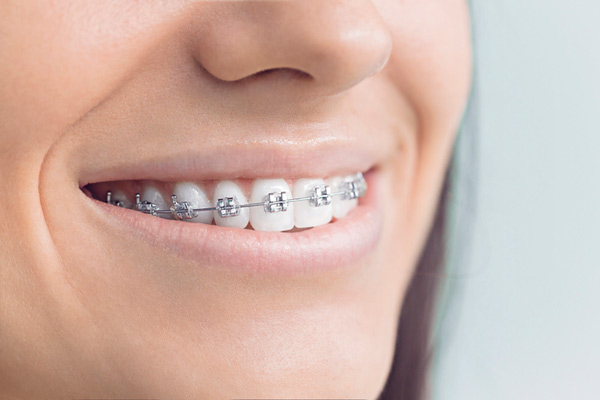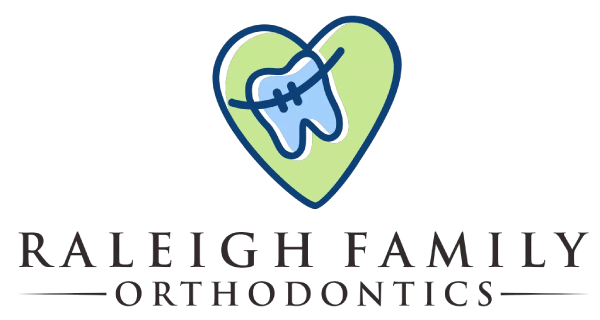Traditional Braces
Raleigh, NC
Traditional Braces provided by Dr. Neill
and Dr. Lee
in Raleigh, NC at Raleigh Family Orthodontics
 Braces are the most common option when considering orthodontic treatment, especially for adolescent care. They work by straightening any misalignments. These misalignments, or malocclusions, can be influenced by losing baby teeth too soon, accidents, or habits like thumb sucking. Braces are the most common option when considering orthodontic treatment, especially for adolescent care. They work by straightening any misalignments. These misalignments, or malocclusions, can be influenced by losing baby teeth too soon, accidents, or habits like thumb sucking.
Likewise, misalignment can be genetically inherited, so if you or someone in your family need braces, it's likely that your kids will, too. While most often you will see children or teens wearing braces, they are also an accepted form of treatment for adults.
At Raleigh Family Orthodontics, we are to answer any questions you may have about braces. You will be in great hands with Dr. Hunter Neill and Dr. Han Lee.
What Do Traditional Braces Look Like?
Traditional braces are made of metal and they are placed on your teeth.
Some types of traditional braces include brackets that are placed on the front of your teeth using an adhesive, and others utilize bands that fit around each tooth. All braces include flexible wires or arch wires, and some braces also require rubber bands or metal ties.
Sometimes, appliances called ceramic braces can be transparent or semi-transparent in order to appear the same color as your teeth. Because ceramic brace material is a bit more fragile, it may take more gradual adjustments and demand a longer wear. Furthermore, they require meticulous oral hygiene in order to remove stains that could accumulate from coffee, tea, dark wines, or smoking.
How Do Traditional Braces Work?
There are several important features to keep in mind when considering or caring for traditional metal braces:
| • |
The brackets or bands in braces are there to be the "anchor" of the teeth - they adhere to the teeth while flexible wires or arch wires hold the brackets or bands together, applying pressure to slowly guide teeth into proper alignment.
|
| • |
When rubber bands or metal ties are used, they link the brackets to the wire, which creates pressure to help straighten and align your teeth.
|
| • |
During orthodontist visits, we will periodically tighten your braces so steady pressure can straighten your teeth gradually, all the while aligning your jaw.
|
| • |
If your underbite or overbite is severe, our doctors will have you wear a device called headgear at night, to redirect or guide your jaw growth while patients are in development phase. Unlike braces, this appliance is removable.
|
| • |
Retainers are usually worn at night after orthodontic treatment like braces is completed. |
How Do I Care for My Braces?
Since traditional braces involve many different small parts, food can get stuck in them more easily than without them. It's very important to be more meticulous when brushing your teeth, because food that hasn't been dislodged from your braces and teeth can leave stains and can increase your risk of developing cavities.
In order to maintain your optimal oral health, there are certain foods you should not eat while you have braces, like popcorn, hard and sticky candy, and gum. These foods can break or damage parts of the braces, and you may experience discomfort while trying to eat these foods.
FAQ's About Braces
What Are the Benefits of Traditional Braces?
Traditional braces are highly effective for correcting various dental issues, including overcrowding, gaps, overbites, underbites, and crossbites. They provide precise control over tooth movement, ensuring optimal alignment and a beautiful smile. Additionally, traditional braces are suitable for patients of all ages, making them a versatile option for achieving orthodontic goals.
How Long Do I Need to Wear Traditional Braces?
The duration of wearing traditional braces varies depending on individual orthodontic needs. On average, treatment time ranges from 18 months to 3 years. Your orthodontist will provide a personalized treatment plan and timeline based on the complexity of your case and desired outcomes.
Are Traditional Braces Painful?
Some discomfort is normal when you first get traditional braces and after adjustments. This is usually temporary and can be managed with over-the-counter pain relievers and orthodontic wax to prevent irritation. Your orthodontist will provide guidance on managing any discomfort during treatment.
Can I Eat Normally with Traditional Braces?
While you can eat most foods with traditional braces, it's important to avoid hard, sticky, or chewy foods that can damage the braces or get stuck in the wires and brackets. Your orthodontist will provide a list of foods to avoid and tips on maintaining a braces-friendly diet.
How Often Do I Need to Visit the Orthodontist During Treatment?
Regular visits to the orthodontist are crucial for monitoring progress and making necessary adjustments. Typically, patients with traditional braces visit their orthodontist every 4 to 8 weeks. Your orthodontist will provide a specific schedule based on your treatment plan.
What Happens If a Bracket or Wire Breaks?
If a bracket or wire breaks, contact your orthodontist as soon as possible to schedule a repair appointment. In the meantime, you can use orthodontic wax to cover any sharp edges and alleviate discomfort. Avoid attempting to fix the issue yourself to prevent further damage.
Can Adults Get Traditional Braces?
Yes, adults can benefit from traditional braces. Orthodontic treatment is effective at any age, and many adults opt for braces to improve their dental health and smile. Your orthodontist will assess your specific needs and develop a treatment plan tailored to your goals.
How Do Traditional Braces Compare to Clear Aligners?
Traditional braces are generally more effective for complex dental issues and provide precise control over tooth movement. Clear aligners, on the other hand, are removable and less noticeable, making them a popular choice for those seeking a more discreet option. The best choice depends on your specific orthodontic needs and lifestyle preferences.
What Should I Do If My Teeth Feel Loose During Treatment?
It's normal for teeth to feel slightly loose during orthodontic treatment as they move into their new positions. This sensation usually subsides as treatment progresses. If you have concerns or experience significant discomfort, contact your orthodontist for advice and reassurance.
Does Insurance Cover the Cost of Traditional Braces?
Many insurance plans offer partial coverage for orthodontic treatment, including traditional braces. Coverage varies by plan, so it's important to review your insurance policy and discuss options with your provider. Your orthodontic office can also help you understand your benefits and payment options.
Braces Are Available at Your Raleigh Orthodontist!
If there are any further questions you may have about caring for your braces, you can call our office at (984) 254-0585 and speak with one of our doctors. If you have any concerns about caring for your braces, we assure you that our team's goal is to tailor your treatment to you, and we will monitor the process and answer your questions along the way.
If you have questions about whether you need braces, schedule a consultation appointment with us here at Raleigh Family Orthodontics. We are here to help!
|


 Braces are the most common option when considering orthodontic treatment, especially for adolescent care. They work by straightening any misalignments. These misalignments, or malocclusions, can be influenced by losing baby teeth too soon, accidents, or habits like thumb sucking.
Braces are the most common option when considering orthodontic treatment, especially for adolescent care. They work by straightening any misalignments. These misalignments, or malocclusions, can be influenced by losing baby teeth too soon, accidents, or habits like thumb sucking.